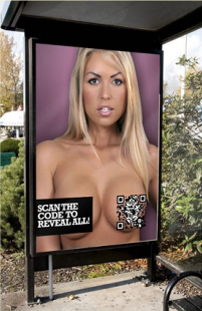As QR codes have gained popularity among companies looking to use new ways to advertise their products and services, they have begun to show up seemingly everywhere you look. Over the course of the past two months, March and April of 2012, I have documented the use of QR codes in business and college settings. Whenever I found a QR code that seemed relatively interesting, I would take a picture of it and then scan it so I would have the web address. All of the pictures on this page are linked to the website that the QR code designated.
 | Several companies and groups have merged the technology with sexual desire and augmented reality in order to create a real-time scopophilic experience, scopophilia being defined by Rose as "...pleasure in looking" (p. 149). Two advertising campaigns by Victoria's Secret and Pink Ribbon use this method in order to attract their audiences to scan QR codes leading to their respective websites. These advertising campaigns use pictures of naked, QR code-censored women that prompt viewers to scan the code in order to reveal the "secret" or to "reveal all." These advertisements play on male heterosexual or female homosexual voyeuristic tendencies in order to get viewers to interact with the ads. Rose defines voyeurism as "...a way of seeing that is active; it distances and objectifies what is looked at" (p. 159). |  |
| Previous | Next |
| Table of Contents |
| Works Cited |
| Contact the Author |